May-28-04
 | | Honza Cervenka: Great game. Really funny is following variation of accepting of sac: 27...Rxg7 28.hxg7 Rg8 29.Rxh7 Qg1+ 30.Nd1!! (But not 30.Ka2? Qg6) 30...Qxd1+ 31.Ka2 Kb7 32.Rf8 Bxd2 33.Rb8+ and 34.g8=Q  |
|
| May-28-04 | | Catfriend: Reminds me of the immortal Queen-Sac game - Adams vs. Torre |
|
| May-28-04 | | kevin86: Another circus of queen sacs and rook sacs! A sparkling finish! |
|
| May-28-04 | | ajile: I don't get why black can't play 21...Rdf8. Is QxR RxQ,RxR NxR, H7 Nxh7, RxN so bad for black? And where is the win after 22. Qg4+ ? |
|
| May-28-04 | | AdrianP: <Honza> Great variation, I like 30 Nd1!!. But there's something wrong with the end of it, so far as I can see. Isn't there still a black Rook on g8...? Or is there some reason I'm missing why Black cannot play 33...Kxb8 e.g. Kxb8 34. Rh8 Qg1. |
|
| May-28-04 | | AdrianP: <Honza> Did you mean: 27...Rxg7 28.hxg7 Rg8 29.Rxh7 Qg1+ 30.Nd1!! (But not 30.Ka2? Qg6) 30...Qxd1+ 31.Ka2 Kb7 32.Rf8 Bxd2 <33. Rxg8 34.Rb8+ and 35.g8=Q  > That looks pretty forced and sound to me. > That looks pretty forced and sound to me. |
|
| May-28-04 | | MatrixManNe0: Accursed Vienna Game...
Ahem... anyway... gah! Closed Game!!
Pheh... 12. gxh5 seemed a little odd to me... 12. g5 would keep the position sealed, and with gxh5, white opens the position a little, and if black happens to break open the position, white's king would be in great trouble. On a plus for white, white holds a good spatial advantage on the kingside. I would have liked to have seen more of this game, I believe black resigned too quickly. 21...Rdf8 doesn't seem to accomplish much, by trading off the kingside pieces, black is stuck with awkwardly trapped queenside pieces. Not only that, but white has the response of Qg4+ when the king must retreat. RxR, RxR, Rf1 either controls the f-file, or trades off the queenside pieces where white has the obvious advantage. In response to Honza's variation, 30... Rxg7 would work fine. Remember: black still has that rook on the final rank! |
|
| May-28-04 | | AdrianP: <MatrixManNeo> Welcome to the site. Honza's variation, so far as I can see, contained an error at the end, but it is still sound. Black has time to nab the Rook on g8 and then go on to force the queening of the g-pawn. Therefore, 30...Rxg7 would have been losing. See my second post above. |
|
| May-28-04 | | dreamerman: <ajile "i don't get why black can't play 21...Rdf8.............? and where is the win after 22.Qg4+?>
24. Qg4+ Kb8 24... Kc7? or 24... b8? runs into problems like 25. Rxf8 Rxf8 Qxg6 with horrable out comes for black. or 22.Qg4+ Kb8 22. Rxf8+ Knxf8 23. Knf5! wins for white |
|
May-28-04
 | | Honza Cervenka: <AdrianP> Of course, you are right. Correct score of my line should have been 27...Rxg7 28.hxg7 Rg8 29.Rxh7 Qg1+ 30.Nd1 Qxd1+ 31.Ka2 Kb7 32.Rf8 Bxd2 33.Rxg8 Qxc2 34.Rb8+ and 35.g8=Q etc., but I forgot to write the 33rd move. <MatrixManNe0> If 27...Rxg7 28.hxg7 Rg8 29.Rxh7 Qg1+ 30.Nd1 Rxg7, then simply 31.Rxg7 Qxg7 32.Bxb4 and white is up with material and should win the game. It's only a matter of technique to win such ending with 2 minor pieces and Rook against lone Queen which cannot defend successfully all weak Pawns. |
|
| Sep-11-04 | | Zaius: Honza, in your line why not 30...Rxg7 to neutralize white's biggest threat? |
|
Mar-08-06
 | | Honza Cervenka: <Zaius> It was already mentioned in my reply to <MatrixManNe0>'s comment. After 27...Rxg7 28.hxg7 Rg8 29.Rxh7 Qg1+ 30.Nd1!! (see the position at diagram) 
click for larger view 30...Rxg7 31.Rxg7 Qxg7 32.Bxb4 white has a won endgame R+B+N vs Q. |
|
Sep-09-09
 | | OBIT: I have to say, I find 30. Qd7 very disappointing. It seems to me, to stay in the spirit of this game, White needs to leave his queen en prise as long as possible. For the ideal resolution, the queen should stay en prise until Black has no choice but to take it. With that in mind, I suggest 30. Rf6! If Black plays 30...Rxg7, White wins by 31. hxg7 Rg8 (or 31...Re8 32. Rxg6 Qd8 33. Bh6, with the same basic idea) 32. Rxg6 Qd8 33. Bh6, threatening Rf8. If Black wants to play along with White's aspirations to set some kind of record for the queen being en prise, he can play 30...Qd8 31. Rxg6 Rxg7 32. hxg7, transposing to the above line. Or, better yet, he can play 30...Nf4 31. Bxf4 exf4 32. R6xf4 Qd8 33. Rf7 Kc8 (33...Qc8 34. Qd4) 34. Rxa7. So, in this line the queen has been en prise for eleven moves, and now I think Black finally has to make the capture: 34...Rxg7 35. hxg7 Kb8 (or 35...Rg8 36. Ra8+ Kc7 37. Rxd8 Kxd8 38. Rf8+) 36. Raf7 Rg8 37. Rf8 and wins. Now THAT to me, would have been a satisfying finish. :) |
|
| Sep-03-11 | | K9Empress: "I have not yet disclosed such things as which of my games I am most fond of, but if you ask me to pick one out off the top of my head, the one I played with Janowski at Paris 1900 comes to mind." --Mieses, quoted in de Greiff's 'Mil y Una Partidas' |
|
| Jun-29-12 | | e4 resigns: Including ! and !! chess should have the LOL symbol.
24.Qg7LOL |
|
| Jun-30-12 | | SimonWebbsTiger: @<e4 resigns>
please don't encourage harrylime |
|
| Jun-06-17 | | TheFocus: First Brilliancy Prize and 500 francs went to Mieses for his game against Janowski. |
|
Mar-15-18
 | | KEG: A fabulous game by Mieses that fully merited the brilliancy prize it received over--among other fine games at Paris 1900--Marshall's spectacular victory over Burn played in the same round of the tournament. Many of the commentators have missed the boat on the early play, wronging criticizing Janowski's strategy at the outset and mistakenly suggesting Janowski was already lost by about move 9 when in fact he was fine until his poor 17th and 19th moves and his blunder on move 22. Despite these errors, Janowski played well for most of the game, making Mieses' achievement all the more impressive. Some of the best commentary on this game appears on this site, in particular the fine analysis by Honza Cervenka. 1. e4 e5
2. Nc3
The Vienna Game, a favorite opening for Mieses.
2... Nf6
Much ink has been spilled over the respective merits of 2...Nf6 and 2...Nc6. Suffice it to say that both moves are fine if properly followed up and the choice is one of style. In either case, an intense tactical duel can be on the horizon. 3. Bc4 Bc5
4. d3 d6
5. f4?!
Many of the possible sharp lines in the Vienna Game involve the advance of White's f-pawn and attacks on the f-file. 5. Na4 (to get the two Bishops) or 5. Nf3 are safer alternatives, but "safety first" was not the motto of either of the contestants here. 5... Nc6
6. f5?!
This hyper-aggressive advance was praised by Teichmann in his commentary on this game, but the preparatory and less committal 6 Nf3 was the soundest move here 6... Na5
Harshly criticized by Marco and by Tartakower-DuMont, but it is neither "valueless" nor the road to a bad game for Black. Janowski's plan to trade Knight for Bishop (giving him his beloved two Bishops) was not unreasonable (and had been played by Tchigorin). Tartakower-DuMont's 6...Nd4 was probably better, but their line is flawed: 6...Nd4 7. Bg5 (weak, better for White would be 7...Nge2 or 7. Nf3) c6 8. a3 b5 (8...a5 or 8...h6 were better moves and better plans) 9. Ba2 Qb6 (giving away what remained of his advantage, which he could have maintained with 9...0-0 or 9...h6). 7. Qf3
"An energetic course, conforming to the idea of the preceding move, namely to lay stress on king side operations" (Tartakower-DuMont). While the text is fine and does indeed fit in with Mieses' planned king-side assault, it hardly leaves White better placed, and is no real improvement over 7...Bb3 which Tartakover-DuMont mock as "without backbone." 7... c6
8. g4?!
Mieses forges onward with his all-out attack. A positional player would try 8. a3 8... h6
Rosenthal in the Tournament Book correctly notes that 8...h5 would be worse for Black, but his analysis of the move is flawed. After 8...h5 9. g5! Black should play 9...Nd7 with approximately equal chances and not Rosenthal's suggested 9...Ng4 allows White to get the better game with 10. Nge2 (rather than Rosenthal's 10. Nh3 after which Black is much better with either 10...0-0 or 10...NxB). Tartakower-DuMont claim a big edge for White after 8...Nd7, but only reach this result with poor analysis: 8...Nd7 (with 9...Qh4+ in mind) 9. g5 NxB 10. dxN Nb6 11. b3 (11. Qd3 was better, though Black is still slightly better) Bb4 (terrible, Black is still better with 11...d5) 12. a3 BxN+ 13. QxB Qe7 (13...h6 was better) 14. Nf3. The text in fact is fine and leaves Black with at least equal chances. Perhaps 8...b5 was better. 9. h4 b5
Teichmann states that Black's position here is "already remedy." Really? Here was the position after 9...b5: 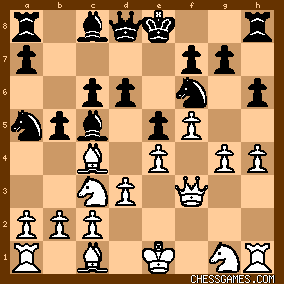
click for larger viewWhile a fierce tactical struggle looms (and occurred!) it is hard to fathom why Teichmann despairs Black's chances here. Fritz 15 fives Black a small edge, and the opportunities for play by both sides is apparent. Indeed, for the next several moves both sides played excellent and creative (and super-aggressive) chess, as I will discuss in my next post on this game. |
|
Mar-15-18
 | | KEG: Post II
10. Bb3 NxB
10...h5 immediately was better
11. axB h5
12. gxh5
"Much stronger than 12. g5" (Schlechter). After 12. g5, Black gets good play with 12...Ng4 (and not 12...Nd7 as suggested by Tartakower-DuMont). The text is definitely best and warrants the ! Rosenthal gave it in the Tournament Book. Chances are now roughly equal.
12... Nxh5
Contrary to the commentary of Tartakower-DuMont, 12...Rxh5 was also fine for Black after Tartakower-DuMont's 13. Bg5 or after the better 13. Be3. 13. Nge2 Qb6
Teichmann and Marco condemned the text and claim 13...Qc7 was best, but both moves seem sufficient to maintain the balance. The following moves reveal that Black is just fine until Janowski's 17th move. 14. Ng3 Nf6
15. Bg5 Bb7
16. h5!
This excellent move threatens h6, and the position is dangerous for both sides. The position was now: 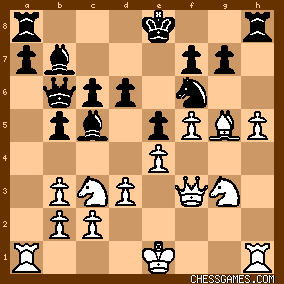
click for larger view16... Nh7!
An excellent reply to Mieses' threat.
17. Bd2 0-0-0
"Hoping at one stroke to have displaced the center of gravity, but White shows that the king's-side is still the main theater" (Tartakower-DuMont). Janowski's plan here backfires. His King is still in potential jeopardy and Mieses' King-side attack only picks up steam. Better by far was 17...Nf6 now that the Bishop had retreated. The position was now:
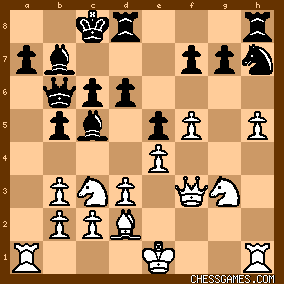
click for larger view18. h6!
"The pivot" (Tartakower-DuMont).
18... g6
Janowski has a difficult position because of his 17th move, but he now hangs tough. Both the text and 18...gxh6 were god choices. Schlechter and Tartakower-DuMont condemn the latter choice, but after 19. Rxh6 f6 Black remains very much in the game. 19. 0-0-0
Mieses now can bring his Queen's-side Rook into the fray and throw everything into his King-side attack. 19... Rhg8
Janowski had to make a difficult decision here, and the text was not best. If 19...g5 White would have strong play after 20. Nh5 (better than Schlechter's 20. f6). 19...Bf2? would lose to 20. fxg6 or 20. Rdf1 (but not Tartakower-DuMont's 20. Nce2). Best was 19...Kb8.
20. fxg6 fxg6
21. Rdf1
The position was now:
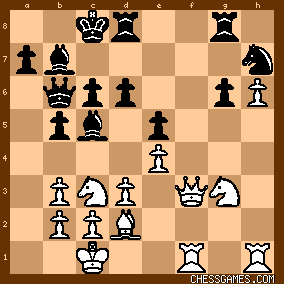
click for larger viewCould Janowski have held this position? For the reasons I will cover in my next post, I claim the answer is Yes, and that Janowski was in the game until his poor 22nd move--and then only because of a remarkable combination by Mieses in which he left his Queen en prise for six moves! |
|
Mar-16-18
 | | KEG: Post III
Janowski's next move came in for much criticism: 21... Kb8
"Why Black allows the enemy Queen to invade on f7 is incomprehensible" (Marco). Marco goes on to suggest 21...Qc7. But Janowski would have been fine after the text had he not blundered on move 22 (see below). 21...Qc7 is no big improvement on the text, since White is still much better after 22. Nd1 (or 22. Nge2). Marco is definitely correct that 21. Rdf8? would be bad after 22. Qg4+ Kb1 23. RxR+ (but not 23. Qd7? Qc7! [far better than Marco's awful 23...Nf6?]) NxR [or 23...RxR 24. Qxg6 as noted by dreamerman on this site] 24. Qh4! (and not Marco's 24. h7 because of 24...Rh8 or 24. Nh5 because of 24...Bc8). 22. Qf7
"The initial move of a fine combination" (Teichmann). The position was now:
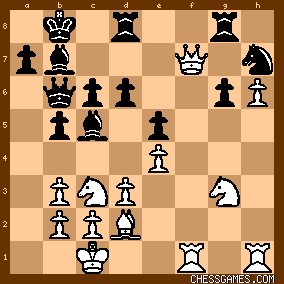
click for larger view22... Rh8?
The losing move which Mieses proceeds to demolish with a fabulous series of sacrifices. As Marco pointed out, 22...Qc7! saves the came for Black here. Marco's line is correct until the last Black move: 22...Qc7 23. QxQ+ KxQ 24. Rf7+ Rd7 25. Rhf1 Bc8 (and not Marco's 25...Rgd8 26. Rg7). 23. Qxg6
"Brilliant and deeply calculated" (Schlechter).
23... Rdg8
"Will he win a piece? (Schlechter). "Obviously Janowski by his previous moves thought he would now win the Knight on g3" (Marco). The position was now:
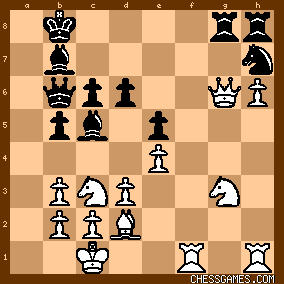
click for larger viewBest for Black had been 23...Bc8, though White would still have the game in hand. But the text (23...Rdg8) certainly appears to win the g3 Knight with the Rook skewer. But now came a move that must have hit Janowski like a thunderbolt: 24. Qg7!!!
"This brutal move was apparently overlooked by Black when he gave up the g-pawn" (Teichmann). 24... Bc8
Black has nothing better. If 24...RxQ 25. hxR Rg8 26. RxN Qd8 27. Nf5 (Tartakower-DuMont's move, even stronger was 27. Nh5) or 26...d5 27. Rh8 Qd8 28. Rfh1 Kc7 (28...Bc8 is slightly better but still hopeless) 29. Nf5 Bc8 30. RxR QxR 31. Rh8 and wins (Teichmann). 25. Nf5!
The only winning move--and a pretty one is was. The Queen is still hanging! 25... BxN
25...Qc7 was better, but insufficient.
26. RxB
26. exB was even better, but the text is plenty good enough. The position was now:
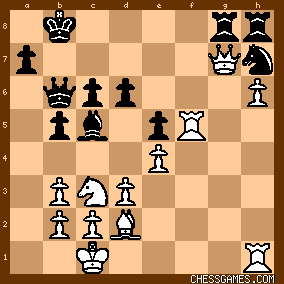
click for larger viewWhite's Queen is still en prise. Can Black take it now? Stay tuned. |
|
Mar-16-18
 | | KEG: Post IV
The answer to the question with which I ended my last post is an emphatic "NO," Janowski could not have played 26...RxQ here. If 26...RxQ 27. hxR Rc8 28. RxN Qd8 29. Rf8 or 27...Rg8 28. RxN Qd8 29. Bh6 d5 30. exd5 Qc8 31. Rf3 Be7 32. dxc6 Qxc6 33. Rf8+ So Janowki played:
26... Bb4
26...Qd8 was "better" though Black would still be doomed. 27. Kb1
27. Qe7 or 27. Qd7 but the text is more spectacular, since the Queen has now been en prise for four consecutive moves, the position now being: 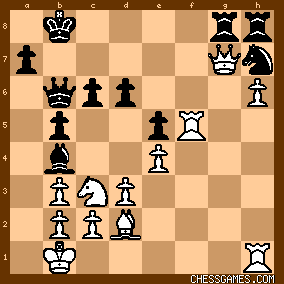
click for larger viewCan Janowski take the Queen now? This time the answer is a bit more complex. Taking the Queen was probably best, but White still wins using what Honda Cervenka on this site has aptly called a "Really funny variation": 27...RxQ 28. hxR Rg8 29. RxN Qg1+ leaving: 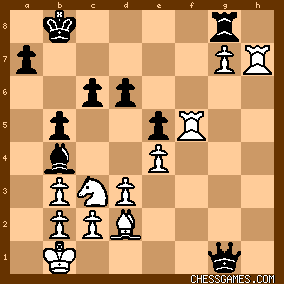
click for larger viewHere White wins with the spectacular 30. Nd1!! [and not Marco's 30. Ka2 Qg6! and Black survives (Marco only gives the flawed line 30...Rxg7 31. Rf8+ Kb7 32. Rg8! and wins)] 30...Kb7 31. BxB (a more reasonable line than Honda Cervenka's 30...QxN+ ?? 31. Ka2 Kb7 32. Rf8 BxB 33. RxR and wins, but only because of Black's awful 30th move in this line). Anyway, let's get back to the game. After 27. Kb1, Janowski played: 27... BxN
This was even worse than 27...RxQ.
28. bxB
For the fifth consecutive move, White's Queen is en prise: 
click for larger viewShould Janowski have taken the Queen now? Stay tuned. |
|
Mar-16-18
 | | KEG: Post V
In fact, Janowski should probably have played 28...RxQ, but this would not have saved him in light of 29. hxR Rg8 30. Rf7 (30. RxN also wins, but now it's more difficult after 30...Qg1+) Janowski's actual move was no improvement:
28... f8
29. Rhf1
Logical and a winning move, but faster would have been 29. Qe7 or even the diabolical waiting move 29. Kb2. Now, for the sixth consecutive move (!!) White leaves his Queen en prise: 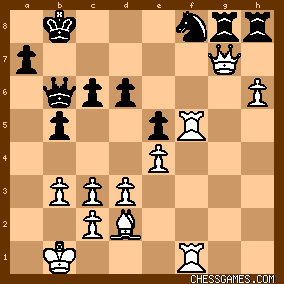
click for larger viewCan Janowski take the Queen now? Obviously not: 29...RxQ 30. hxR and Black is finished. The best chance for Janowski in the last diagrammed position was to concede his last move was rotten and play 29...Nh7. Instead, Janowski played: 29... Ng6?
And not, after leaving his Queen en prise for six consecutive moves, Mieses played: 30. Qd7
This is sufficient for victory, but even better was the sweet 30. Rg5!! (leaving the Queen to be captured for a record 7th move). Of well, Mieses has thrilled us for quite a long while in this game, so we have no basis to grump is he seeks a prosaic ending to the game. 30... Rd8
"Best" would have been the line given by Rosenthal in the Tournament Book, though it would not have saved the day in the long run: 30...Qc7 31. QxQ+ KxQ 32. Rf7+ Kb6 (32...Kb8 was the only way to continue the game, but it too would have lost after 33. Rg7 or 33. R1f5) 33. Be3+ (better still would be 33. R1f6, but Black is dead in any case) c5 34. R1f6. 31. Qe6 Nf4
31...Nf8 would get demolished by 32. RxN as pointed out by Tartakower-DuMont). 32. BxN exB
33. Rfxf4
The position was now:
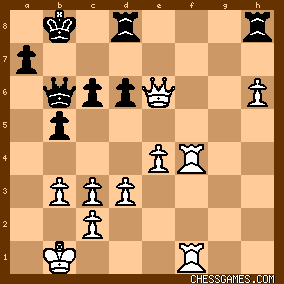
click for larger viewThe dust has settled and Mieses is now up two pawns and has--to quote Tartakower-DuMont--"a dominating position." Mieses closed out the game nicely from here as I will discuss in my next and final post on this game. |
|
Mar-16-18
 | | KEG: Post VI
After 33. Rfxf4 the result was not in doubt, but the concluding moves were not without interest. 33... Qc5
33...c5 or even 33...Ka8 were better, though also hopeless. 34. Rf7!
Crushing. White threatens 35. Qe7.
The position was now:
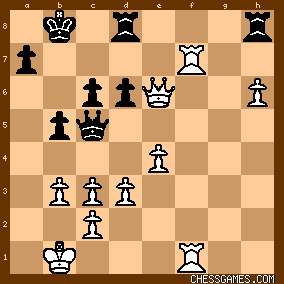
click for larger view34... Qg5
"Prevents 35. Qe7 but there follows another surprise" (Tartakower-DuMont). The only even forlorn hope here for Janowski was 34...Qe5. 35. Rf8
"Another pretty move which finishes the game at once" (Teichmann). This is a pretty way to end the game (though the brutal 35. Rg7 would also have ended the game. The position after 35. Rf8 was:
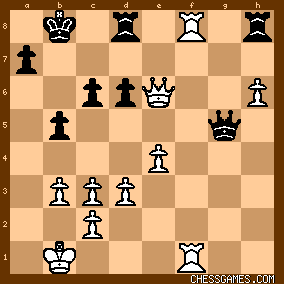
click for larger view35... Qc5
Hopeless, as was everything else. If 35...R(either)xR 36. RxR RxR 37. Qxd6+ Kb7 38. QxR "theatening Qg7 and Queening the pawn" (Teichmann). 36. Qe7
1-0
A magnificent game by Mieses. |
|
Jun-12-21
 | | Phony Benoni: "Herr Mieses, I knew E. Z. Adams. You are no E. Z. Adams." -- David Janowski. |
|
|
|
|





